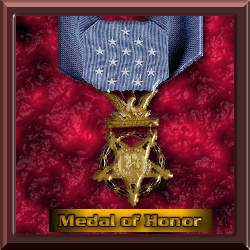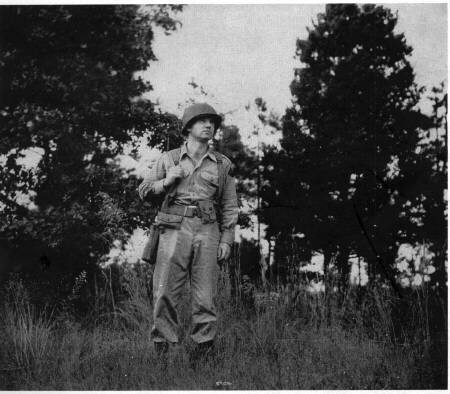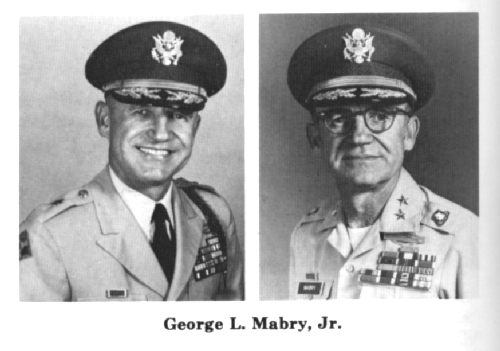


LTC George L. Mabry Jr.
Commander, 2nd Bn, 8th Infantry
November 20, 1944

Photo Courtesy of Irving Smolens



LTC George L. Mabry Jr.
Commander, 2nd Bn, 8th Infantry
November 20, 1944

Photo Courtesy of Irving Smolens

Courtesy of Irving Smolens
George L. Mabry Jr., born 14 September 1917, in Stateburg, Sumter County, South Carolina.
Attended elementary and high school in Sumter county. Graduated from Presbyterian College,
Clinton, SC, in 1940 with a B.A. Degree and a Reserve Commission as 2nd Lieutenant.
Volunteered for Active Duty and joined the 2nd Battalion, 8th Infantry Regiment, 4th
Infantry Division, at Harmony Church Area, Fort Benning, Georgia on 5 July 1940 until
January 1946. Landed H-Hour D-Day on Utah Beach, June 6, 1944 with the 2nd Bn, 8th
Infantry Regiment. Fought through France, Luxembourg, Belgium and into Germany. Advanced
in rank from 2nd Lieutenant , Platoon Leader to Lieutenant Colonel, Battalion Comander in
the 2nd Bn, 8th Infantry Regiment from 1940 to 1946. Received the following decorations
and awards during WWII: Medal of Honor, Distinguished Service Cross, Silver Star, Bronze
Star Medal with "V" Device, Arrowhead and Oak Leaf Cluster, Purple Heart, Presidential
Unit Citation, Distinguished Service Order (British), Belgian Fourragere, Combat Infantry
Badge, and five campaign medals. After thirty-five years Active Military Service, retired
as a Major General. Married, father of one daughter and two sons, and grandfather of five
grandchildren. Major General Goerge L. Mabry died on July 13, 1990.
During the Normandy Invasion
Sergeant Pike of E Company joined Mabry's group. As Mabry led the men across the
causeway, headed toward Pouppeville, he caught up with Lieutenant Tighe of the 70th
Tank Battalion. Tighe had lost three tanks to land mines but was moving cautiously
ahead with his remaining two Shermans. Mabry put infantry in front and pushed on,
urging speed because they were so exposed on the causeway and were taking mortar fire,
simultaneously urging caution because of the mines. They came to a bridge over a
culvert and figured it must be prepared for demolition; further, the scouts reported that
they had seen some Germans duck into the culvert.
Mabry sent troops out into the flooded fields to pinch in on both sides of the culvert. The
Germans surrendered without putting up a fight. Mabry had them disconnect the charges,
then sent the prisoners back to the beach and pushed on.
After the guards put the prisoners into a landing craft, to be taken back to the
USS Bayfield for interrogation, they reported to Van Fleet. It was 0940. Van Fleet radioed
General Barton on Bayfield, "I am ashore with Colonel Simmons and General
Roosevelt, advancing steadily." As new waves of landing craft came in, Van Fleet and
Roosevelt sent them through the holes in the seawall with orders to move inland. Already
the biggest problem they faced was congestion on the beach. There were too many troops
and vehicles, not enough openings. Sporadic incoming artillery fire and the ubiquitous
mines made the traffic jam horrendous. Still, at 1045, Van Fleet was able to radio Barton,
"Everything is going OK." The beach area was comparatively secure, the reserve
battalions were coming ashore.
Mabry pushed forward on the causeway. He kept cautioning his scouts. "You know," he
said to Sergeant Pike, "the paratroopers are supposed to have taken this town
Pouppeville, but they may not have. Let's not shoot any of our paratroopers." Pike said
OK.
The scouts got to the western edge of the flooded area. "We could see the bushes and a
few trees where the causeway ended," Pike recalled, "and then I saw a helmet and then it
disappeared, and I told Captain Mabry that I saw a helmet up there behind those bushes
and he said 'Could you tell if it was American or German?' and I said, "I didn't see
enough, I don't know, sir."
The men on the far end of the causeway shot off an orange flare. "And these two guys
stood up and the first thing we saw was the American flag on their shoulder and it was
two paratroopers. They said, '4th Division?' and we said, 'Yes.' "
Lieutenant Eugene Brierre of the 101st was one of the two paratroopers. He greeted Pike
and asked, "Who is in charge here?" Mabry came up and replied, "I am."
Brierre said, "Well, General Taylor is right back here in Pouppeville and wants to meet
you."
It was 1110. The linkup between the 101st and the 4th Divisions had been achieved. Exit
1 was in American hands.
Mabry talked to Taylor, who said he was moving out to accomplish further objectives,
then proceeded through Pouppeville in the direction of Ste. Marie-du-Mont. There were
forty or so dead German soldiers in Pouppeville, testimony to the fight the 101st had
been engaged in. Near Ste. Marie-du-Mont, Lieutenant
Louis Nixon of Easy company, 506th, 101st asked Mabry for a bit of help from the two
tanks; Mabry detached them and they went to work. Then it was on to Ste. Marie-du-
Mont, where the Mabry force helped the paratroopers secure the town.
Courtesy of "The Victors", by Stephen Ambrose
On June 14, 1995 the new Noncomissioned Officer’s Academy at Fort Jackson,
South Carolina, was dedicated in memory of General Mabry who died July 13, 1990.
Courtesy of Don Collins and the Mabry Family Web Page